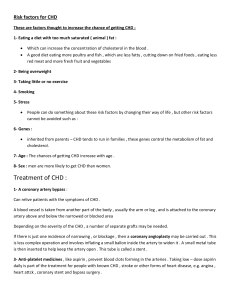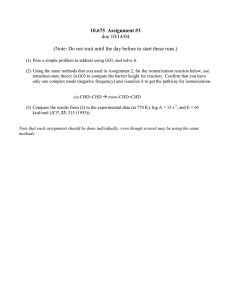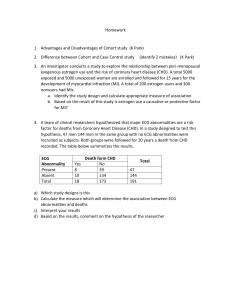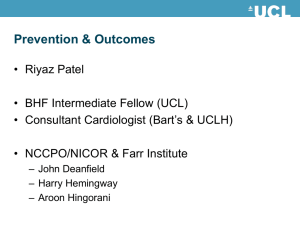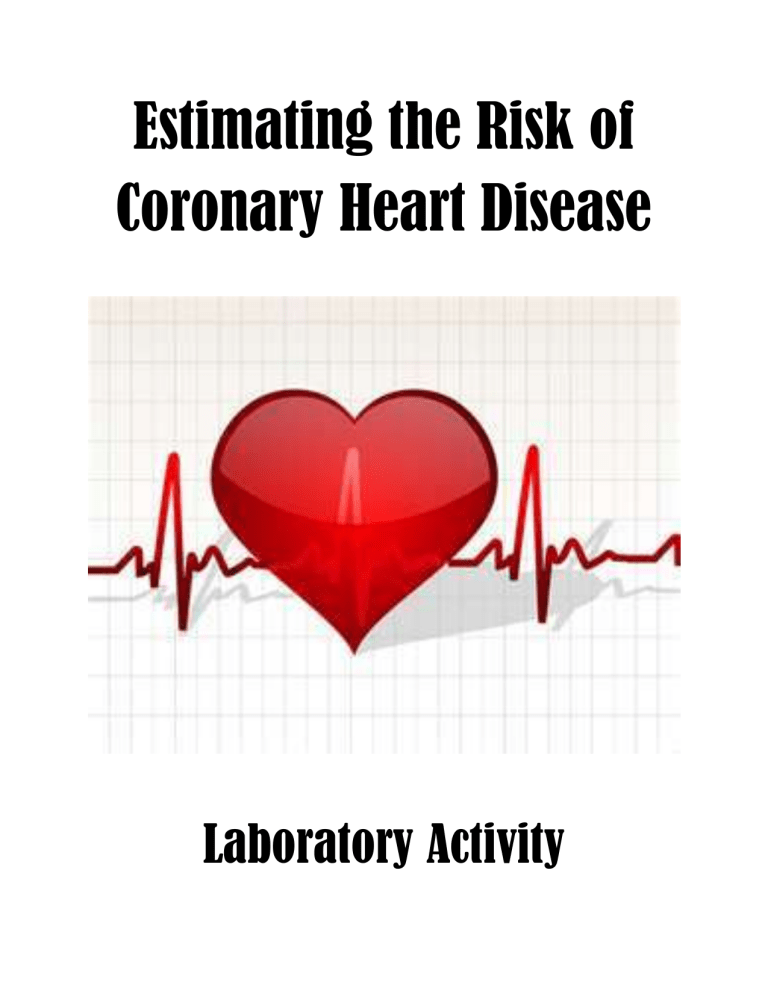
Estimating the Risk of Coronary Heart Disease Laboratory Activity ESTIMATING RISK OF CORONARY HEART DISEASE – (CHD) INTRODUCTION In this activity you will do what doctors do when they see patients for heart problems. One of the main things they do is take a case history of their patients. A case history is all the information about a person’s habits, health, and background. This activity will show how certain factors can be used to help predict if a person will have CORONARY HEART DISEASE. We have periodically spoken of factors thought to be related to the occurrence of heart disease. For example, if all other factors are equal, a person with a poor diet with respect to CHD (too much fat, sugar, etc.), is thought to be more likely to end up with CHD than a person on a good diet (low fat, low sugar, etc). This does not say that either individual necessarily will or won’t have CHD as we are dealing with statistical relationships rather than with a simple cause and effect relationship. In general, the higher your total risk factor, the more likely that you will get CHD. In other words, the relative frequency of CHD will tend to be higher in a group of people with high risk factors. It is important to learn about the CHD risk factors to avoid loading the dice in favor of CHD. Avoiding unnecessary risks is an important part of preventative medicine. For our study of risk factors, we will use Table 1. This table is modified from one produced by the Michigan Heart Association. Similar tables of CHD risk factors have been produced by different groups. Some charts include a few different risk factors such as personal stress, vital lung capacity, and diabetes. In addition, charts of heart risk factors are not identical in the way they rate the relative importance of each factor. Some rate nutritional factors highest, others rate smoking or blood pressure highest. All of these charts are useful however since they tell people whether they should be concerned about the risk of CHD and they suggest ways for individuals to lower their risk. In Table 1, nine risk factors are listed. For each risk factor, the degree of risk increases from left to right. Note that for age 10-20 the risk is 1, but for age 61 and over the risk factor is 8. This means that people over 60 are considerably more likely to have CHD than those under 20. It does not necessarily mean the older individuals are eight times as likely to have CHD than the younger group. Look at the 9 factors in Table 1 that are related to coronary heart disease. Each factor is listed with numbers corresponding to the risk of having heart disease. For example a person with a poor diet is more likely to end up with coronary heart disease than a person with a good diet and will have a higher number on the chart. The higher a person’s total number for all of the risk factors, the higher their chance for heart disease. PROCEDURE 1. Copy the data table below on to your own paper. Rose Age Sex Weight Blood Cholesterol % Calories from saturated fat Systolic Blood Pressure Tobacco Smoking Exercise Family History TOTAL SCORE Tom Freddie Maria Mrs. Jones TABLE 1 1. Age 10-20 21-30 31-40 41-50 51-60 61 and over 1 2 3 4 6 8 Female 40-50 Female over 50 Male 1 2 3 5 More than 2 kg below standard weight Standard weight + 2 kg 3-10 kg overweight 11-30 kg overweight 31-40 kg overweight 40 or more kg overweight 0 1 2 3 4 5 4. Blood Cholesterol Level < 180 181-205 206-230 231-255 256-280 281-300 0 1 2 3 4 5 5. % of total calories from saturated fat < 10 11-20 21-30 31-40 41-50 > 50 0 1 2 3 4 5 6. systolic blood pressure 100-120 121-140 141-160 161-180 181-200 > 200 1 2 3 4 6 8 7. Smoking Non-smoker Cigar/pipe < 10 cigarettes per day 11-20 cigarettes per day 21-30 cigarettes per day > 30 cigarettes per day 0 1 2 4 6 10 Intense regular exercise Moderate regular exercise Intense Recreational exercise only Moderate recreational exercise Light recreational exercise Complete lack of exercise 1 2 3 5 6 8 No known family history 1 relative had CHD after age 60 2 relatives had CHD after age 60 1 2 3 1 relative had CHD before age 60 2 relatives had CHD before age 60 3 relatives had CHD before age 60 2. Sex 3. Weight 8. Exercise 9. Family History Female < 40 4 6 7 2. Use the following case histories and the accompanying RISK FACTOR CHART to fill in data table. CASE #1 – Rose CASE #2 – Tom Age: 29 Age: 47 Weight: 1 kg over standard wt Weight: 9 kg over standard wt Blood Cholesterol: 200 Blood Cholesterol: 235 % Calories from Saturated Fat: 30% Calories from Saturated Fat: 44 Blood Pressure: 120/80 Blood Pressure: 160/90 **Smoking: none **Smoking: 2 packs/day Exercise: exercises at work and for recreation Exercise: none Family History: both parents and grandfather had Family History: 1 grandfather had early CHD CHD in their 50’s CASE #3 – Freddie CASE #4 – Maria Age: 52 Age: 29 Weight: 11 kg over standard wt Weight: 2 kg below standard wt Blood Cholesterol: 260 Blood Cholesterol: 185 % Calories from Saturated Fat: 44 Calories from Saturated Fat: 24 Blood Pressure: 170/100 Blood Pressure: 80/60 **Smoking: 1 ½ packs/day **Smoking: 3 packs/day Exercise: watching football on tv (NONE) Exercise: occasional walking Family History: father, brother, grandfather had Family History: none CHD in their 60’s **Assume there are 20 cigarettes per pack CASE #5 – Mrs. Jones Age: 40 Weight: 35 kg over standard wt Blood Cholesterol: 270 % Calories from Saturated Fat: 41 Blood Pressure: 160/100 **Smoking: none Exercise: none Exercise: none Family History: father died of heart attack in his 50's EVALUATING TOTAL RISK FACTOR: TOTAL SCORE SCORE 5-11 12-18 19-24 25-31 32-40 41-63 RISK well below average below average average moderate high much too high Copy the following questions on your own paper and write complete sentence answers. 1. List each of the 5 case studies total score and risk for CHD. Use the TOTAL SCORE chart above. 2. For each individual at high risk, what SPECIFIC ADVICE would you give them to help them decrease their risk of CHD? 3. If you have a family history of CHD does that mean that you will have CHD? Explain your answer. 4. In this lab there are 9 risk factors. What are the risk factors that you can control and how would you control each one? CHD Lab Guidelines & Answer Key This lab is somewhat self explanatory to administer. I will discuss the introduction with the class together first. I have a class set of instructions made and then have the students make their own data table. The students will then fill in the data table using Table 1, and answer the discussion questions at the end with complete sentences. Depending on your level of student you may want to add to the discussion questions. Answer Key Rose Tom Freddie Maria Mrs. Jones Age 2 4 6 2 3 Sex 1 5 5 1 2 Weight 1 2 3 0 5 Blood Cholesterol 1 3 4 4 4 % Calories from saturated fat 2 4 4 2 4 Systolic Blood Pressure 1 3 4 1 3 Tobacco Smoking 1 10 6 10 0 Exercise 1 8 8 2 8 Family History 7 4 2 1 4 TOTAL SCORE 17 43 42 23 33 DISCUSSION QUESTIONS 1. Tom Young - highest Maria – lowest 2. Various answers can be given – more exercise, quit smoking, better diet, etc 3. Not necessarily – but does have a higher risk 4. Not necessarily – but chances are good they won’t
